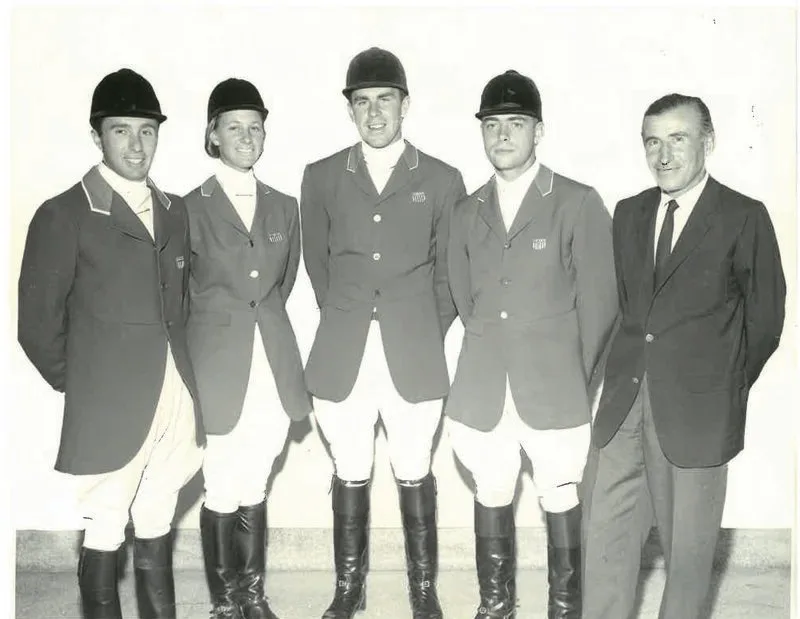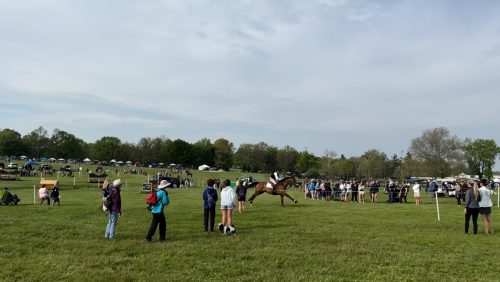With the 2020 Tokyo Olympic Games upon us, what better time to take a look back at some of our coverage from the 1964 Tokyo Olympic Games, where women were allowed to compete in eventing for the first time and the U.S. Eventing Team took team silver. This story about the eventing competition was written by none other than Michael Page, one of the members of the team.
In 1964, the eventing competition looked quite different from 2021: The competition was held in Karuizawa, a forested area 90 miles from Tokyo, and the cross-country test covered roughly 20 miles and consisted of five sections— a 6,000-meter (3.7-mile) road phase, the 3,600-meter (2.2-mile) steeplechase, a second 13,920-meter (8.7-mile) road section, a 7,200-meter (4.5-mile) cross-country course, and a final 1,980 (1.2-mile) road phase.
(1964 Editor’s Note: The following article presents the viewpoint of the four riders and horses which won the silver medal for the United States, and more particularly that of Michael Page and The Grasshopper who were fourth in the scoring, less than 2 points away from the individual bronze medal.)
Looking back to the Olympic Three-Day Event held in Karuizawa, Japan on Oct. 17-20 has been a pleasant experience shared, I am sure, by all those fortunate to have taken part, either as competitor or spectator. One of the reasons for the consistently good showing of the U.S. team was the support and encouragement shown by the many Americans who were very much in evidence and enthusiastically backing and helping the four riders and their mounts.
The technical and organizational difficulties inherent in putting on a successful event are well known to anyone even vaguely associated with combined training. An Olympic Three-Day Event presents a picture of proportionately greater magnitude. The Japanese Equestrian Federation is to be commended for achieving a completely successful event, well in keeping for the overall excellence of the Games.
Twelve nations were brought together at the Seizan Hotel which was taken over by the Organizing Committee and run as a separate part of the Olympic Village. The stabling for the approximately 60 horses was about 100 yards from the hotel and the training areas all within easy hacking distance. On arrival there was a mandatory five-day quarantine, during which time the horses were confined to a relatively small area. Part of this area cut into a hill which in the winter was used as a ski slope and was sufficiently steep so that the condition of the horses was not unduly penalized by this enforced sojourn. The Italian horses were the last to arrive and were freed from this quarantine restrictions only two days before the event.
Before the start of the main topic of discussion, aside from analyzing the relative merits and presumed difficulties of the competing nations, was the cross-country course. It has been suggested that this was the one area that in fact might justifiably been criticized, and this only in regard to the size and relative difficulty of the fences. For an Olympic course it was not sufficient. It is necessary to add and emphasize, however, that the contributing factor of a heavy steady rain did in fact elevate it to a course of Olympic proportions. Those who assumed that it was to be something of a steeplechase either never arrived or did so with somewhat more difficulty than anticipated, proving that the speed and endurance test did fulfill its purpose. I think perhaps the organizers had an arrangement about the weather and were one-up on us all.
ADVERTISEMENT
The jumping course on the third day required a show jumper. There was no gift. One had to ride a clear round and have the horse underneath which to do it. The results of the third day again played an important part in the team and individual placing, as can be seen from a study of the placings and scores before the final test.
The silver medal won by the United States was in fact a real team effort and required what were outstanding rides from each combination.

The team of (from left) Michael Page, Helena “Lana” DuPont, Michael Plumb, Kevin Freeman and coach Stefen von Visy won team silver at the 1964 Olympic Games. Carmine Petriccione Photo
We were fortunate that the USET and William Haggard together made Bold Minstrel available when Markham was lost on the flight over. (Editor’s note: Markham, Plumb’s original mount, had to be euthanized during the flight to Japan.) Michael Plumb, as can be imagined, was at a tremendous disadvantage having to compete in an Olympic Games after only riding the horse for the two weeks beforehand. However from the excellent dressage ride on the first day to the “must” clear round to protect the Medal on the last day over a trappy jumping course, Plumb and Bold Minstrel never once shook the confidence placed in them both.
For Kevin Freeman and Gallopade the event presented a rather different picture. We were all aware that even the best dressage test of which the horse was capable of, in all probability, would. not put him score-wise in a contributing position. Thus Kevin was faced with the task of having to make a very fast, and of course clear, ride on the second day to move his total points up sufficiently to insure us a third usable score should one of the other horses have difficulties. Gallopade was a “used” horse at the end of the day, but we all delighted at the job done by Kevin in getting so much from him and home clear. One of the most outstanding rides of the day.
Lana duPont was faced not only with riding in her first Olympic Games but also with being the first and only woman competitor in an Olympic Three-Day Event. The pressure of competition was understandably greater on her than it was for the rest of us. Her competent overall showing is a sufficient answer to those thinking that women cannot compete on equal footing in this event. The apparent popularity of the Americans with the Japanese was due in no small measure to the excellent regard with which Lana and Mr. Wister were held as part of the team.
Grasshopper almost missed a chance at what for him at the close of a long career was probably his best event. The concussion of the hard summer gallops had stopped his training a month before departure and it was only due to the program set up by Dr. William Wright of the University of Pennsylvania’s New Bolton Center and implemented by his groom Peggy Grant and stable manager Rene Williams that it was decided at the last minute to give him a try at his third Games. Naturally, we are all happy they did.
(Editor’s Note: While Mr. Page gives credit to others, he certainly deserves a big hand for his superb riding. With the knowledge of The Grasshopper gained in two previous Pan American and one Olympic Three Day Event, he nursed the 16-year-old horse through the steeplechase phase, avoiding the temptation to go for his maximum bonus points, and so achieved clear rounds in the cross-country and stadium jumping tests.)















